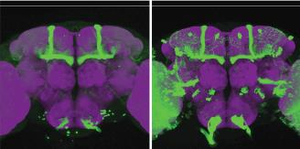Information
- Publication Type: Master Thesis
- Workgroup(s)/Project(s):
- Date: August 2014
- Date (Start): 26. August 2013
- Date (End): 26. August 2014
- First Supervisor: Eduard Gröller
Abstract
Biologists at the Institute of Molecular Pathology (IMP) in Vienna scan brains of the species Drosophila melanogaster with a confocal microscope to find relations between genes, brain structure and behavior. The database contains now more than 40.000 volumetric images, which makes it time-consuming to search for an image of interest. For biologists it would be very help-ful to have a method which can be used to search for specific images and works on the perceptual level of content. The aim of this thesis is to develop a Content Based Image Retrieval (CBIR) method customized for 3D fly brain images. A biologist can choose an image which shows interesting gene expressions and as result images which are visually similar should be retrieved. Exhaustive lit- erature research shows that in the biological field nothing comparable exists. However, CBIR plays an important role in the medical domain, which deals also with 3D images and therefore publications in this area can be seen as related. The voxelwise comparison of two images would be on the one hand computationally expensive and on the other hand not practicable due to image registration errors and anatomical variations of neuronal structures. Creating maximum intensity projections from three directions and applying a principal component analysis on the gray values overcomes the before mentioned drawbacks and delivers satisfying results. The fly brain can be divided into regions, so-called neuropils. The proposed method works on the basis of neuropils. This has, among others, the advantage that not only a global similarity can be computed, but also a comparison of images based on only some of the neuropils is possible. An extensive evaluation of the developed method is given including a parameter space exploration. For example, different lengths of the feature vectors, which describe a fly brain in a lower dimensional space, are tried and also different distance measures are tested. The evaluation shows satisfying results and that the method facilitates the work of biologists when they are looking for similar images to create a hypothesis about the connection of genes and behavior.Additional Files and Images
Weblinks
No further information available.BibTeX
@mastersthesis{Langer_Edith_IR1,
title = "Image Retrieval on Co-registered Confocal Microscopy Image
Collections",
author = "Edith Langer",
year = "2014",
abstract = "Biologists at the Institute of Molecular Pathology (IMP) in
Vienna scan brains of the species Drosophila melanogaster
with a confocal microscope to find relations between
genes, brain structure and behavior. The database contains
now more than 40.000 volumetric images, which makes it
time-consuming to search for an image of interest. For
biologists it would be very help-ful to have a method which
can be used to search for specific images and works on the
perceptual level of content. The aim of this thesis is to
develop a Content Based Image Retrieval (CBIR) method
customized for 3D fly brain images. A biologist can choose
an image which shows interesting gene expressions and as
result images which are visually similar should be
retrieved. Exhaustive lit- erature research shows that in
the biological field nothing comparable exists. However,
CBIR plays an important role in the medical domain, which
deals also with 3D images and therefore publications in this
area can be seen as related. The voxelwise comparison of two
images would be on the one hand computationally expensive
and on the other hand not practicable due to image
registration errors and anatomical variations of neuronal
structures. Creating maximum intensity projections from
three directions and applying a principal component analysis
on the gray values overcomes the before mentioned drawbacks
and delivers satisfying results. The fly brain can be
divided into regions, so-called neuropils. The proposed
method works on the basis of neuropils. This has, among
others, the advantage that not only a global similarity can
be computed, but also a comparison of images based
on only some of the neuropils is possible. An
extensive evaluation of the developed method is given
including a parameter space exploration. For example,
different lengths of the feature vectors, which describe a
fly brain in a lower dimensional space, are tried and also
different distance measures are tested. The evaluation
shows satisfying results and that the method facilitates the
work of biologists when they are looking for similar images
to create a hypothesis about the connection of genes and
behavior. ",
month = aug,
address = "Favoritenstrasse 9-11/E193-02, A-1040 Vienna, Austria",
school = "Institute of Computer Graphics and Algorithms, Vienna
University of Technology ",
URL = "https://www.cg.tuwien.ac.at/research/publications/2014/Langer_Edith_IR1/",
}

 image
image master thesis
master thesis

